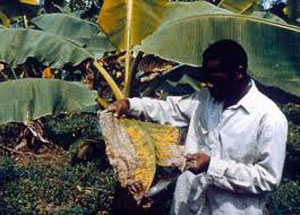THE dreaded plantain crop disease, the black sigatoka, or “burn leaf disease”, is devastating the economy of farming communities along the banks of the Demerara River.
 This was reported by Minister of Local Government & Regional Development Mr. Ganga Persaud, as one of the observations made by the ministerial teams which carried out an outreach in communities along the Demerara River last week.
This was reported by Minister of Local Government & Regional Development Mr. Ganga Persaud, as one of the observations made by the ministerial teams which carried out an outreach in communities along the Demerara River last week.
Farmers at Clemwood, Dora, Endeavour, Susannah’s Rust, Low Wood, Princess Carolina, Sand Hills, Santa Mission, La Harmonie and Alliance are among those whose plantain crops are severely affected, Minister Ganga Persaud said.
“They are suffering heavy financial losses as a result,” he said.
The black sigatoka fungus attacks the leaves of the plantain plants, causing brown streaks which start as small spots, but which spread and eventually “suck out” all of the green from the leaves, giving them a burnt-out look.
Such damage to the leaves affects the yields of the plantain, since having lost their greenness, the leaves can no longer convert sunlight into food for the plant.
The resultant fruits are scrawny and malnourished looking and a total loss to the farmer, since they are impossible to sell or even use as food.
A senior official of the National Agricultural Research and Extension Institute (NAREI), said that the institute was aware of the problem and will soon be targeting them for a technology transfer programme to deal with it.
Such farmers’ training by NAREI is ongoing countrywide, but the NAREI will soon be targeting the Demerara River farmers on cultural practices for the management and control of the sigatoka. These include getting rid of afflicted leaves by burning them and spraying the fungus with an effective fungicide, Aaron Ramroop, Regional Crop Extension Officer of Region 4 (Demerara/Mahaica) said.
NAREI will also organise demonstration plots and farmers field schools to teach the farmers how to grow their plantains free of the dreaded blight.



.jpg)








